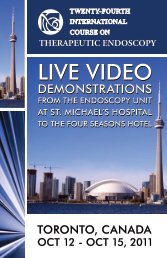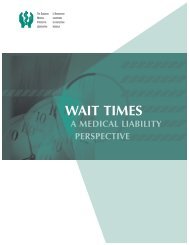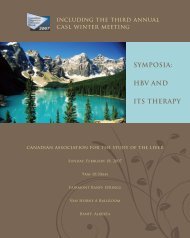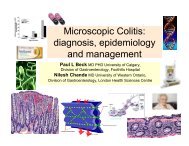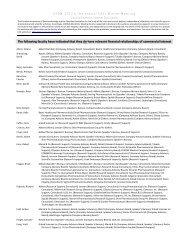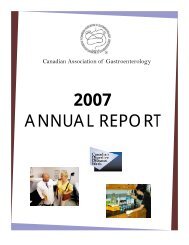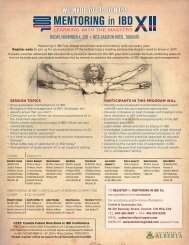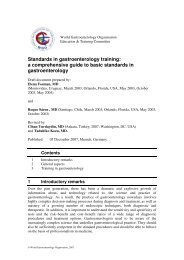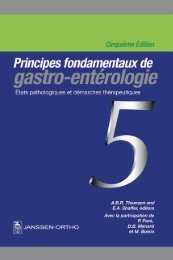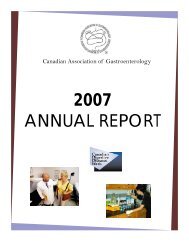Manifestations of Gastrointestinal Disease in the Child
Manifestations of Gastrointestinal Disease in the Child
Manifestations of Gastrointestinal Disease in the Child
Create successful ePaper yourself
Turn your PDF publications into a flip-book with our unique Google optimized e-Paper software.
696 FIRST PRINCIPLES OF GASTROENTEROLOGY<br />
5-10% <strong>of</strong> school-aged children. Many parents worry that <strong>the</strong>re is a serious disease<br />
caus<strong>in</strong>g symptoms. However more than 95% <strong>of</strong> children have no organic<br />
cause for <strong>the</strong>ir symptoms but have a diagnosis <strong>of</strong> functional constipation. A<br />
functional gastro<strong>in</strong>test<strong>in</strong>al disorder is one <strong>in</strong> which <strong>the</strong>re are troublesome<br />
symptoms <strong>in</strong> <strong>the</strong> absence <strong>of</strong> evidence <strong>of</strong> mucosal or anatomic disease. Symptom-based<br />
criteria for functional defecation disorders <strong>in</strong> childhood have been<br />
developed by <strong>the</strong> Rome II work<strong>in</strong>g group.<br />
Disorders described <strong>in</strong>clude:<br />
1. Functional Constipation (FC): This refers to <strong>the</strong> situation where <strong>the</strong>re has<br />
been at least two weeks <strong>of</strong> hard stools (scybalous or pebble-like) for <strong>the</strong><br />
majority <strong>of</strong> stools, or firm stools two or less times a week and no evidence<br />
<strong>of</strong> structural, endocr<strong>in</strong>e or metabolic disease.<br />
2. Functional Fecal Retention (FFR): From <strong>in</strong>fancy to 16 years <strong>of</strong> age, passage<br />
<strong>of</strong> large diameter stools at <strong>in</strong>frequent <strong>in</strong>tervals (< 2 per week) with<br />
associated retentive postur<strong>in</strong>g. Retentive postur<strong>in</strong>g refers to <strong>the</strong> attempts a<br />
child will make to avoid defecation. This <strong>in</strong>cludes contract<strong>in</strong>g pelvic muscles<br />
and squeez<strong>in</strong>g <strong>the</strong> gluteal muscles toge<strong>the</strong>r. This postur<strong>in</strong>g may be<br />
mis<strong>in</strong>terpreted by parents as stra<strong>in</strong><strong>in</strong>g unsuccessfully to stool. FFR is <strong>the</strong><br />
entity most commonly associated with encopresis (soil<strong>in</strong>g).<br />
Constipation <strong>in</strong> this section will refer generally to both functional constipation<br />
and functional fecal retention with and without encopresis.<br />
3.2 Pathophysiology<br />
There is a wide variation <strong>in</strong> what should be considered normal defecation frequency<br />
<strong>in</strong> childhood. The normal frequency <strong>of</strong> bowel movements will depend<br />
on whe<strong>the</strong>r <strong>the</strong> <strong>in</strong>fant is breast or formula fed. Healthy breast-fed <strong>in</strong>fants may<br />
have <strong>in</strong>tervals <strong>of</strong> seven to 10 days between bowel movements, while formulafed<br />
<strong>in</strong>fants may have several per day. Greater than 90% <strong>of</strong> healthy <strong>in</strong>fants pass<br />
<strong>the</strong>ir first bowel movement with<strong>in</strong> <strong>the</strong> first 24 hours after birth, although this<br />
may be delayed <strong>in</strong> premature <strong>in</strong>fants. (Approximately 90% <strong>of</strong> <strong>in</strong>fants with<br />
Hirschsprung’s disease will not pass meconium <strong>in</strong> <strong>the</strong> first 24 hours <strong>of</strong> life).<br />
Infants pass a mean <strong>of</strong> four stools per day <strong>in</strong> <strong>the</strong> first week <strong>of</strong> life and <strong>the</strong> frequency<br />
decl<strong>in</strong>es to about two per day at two years <strong>of</strong> age and 1.2 per day at<br />
four years <strong>of</strong> age. The daily number <strong>of</strong> high amplitude propagated contractions<br />
(HAPC), (powerful peristaltic waves propell<strong>in</strong>g stools to <strong>the</strong> rectum), is<br />
related <strong>in</strong>versely to age. Intest<strong>in</strong>al transit time, which is <strong>in</strong>versely related to<br />
frequency <strong>of</strong> defecation, <strong>in</strong>creases with age (Table 4).<br />
Fibre-rich diets favor <strong>the</strong> retention <strong>of</strong> water and result <strong>in</strong> <strong>in</strong>creased stool<br />
weight and volume, shorter transit time and <strong>in</strong>creased stool frequency.



